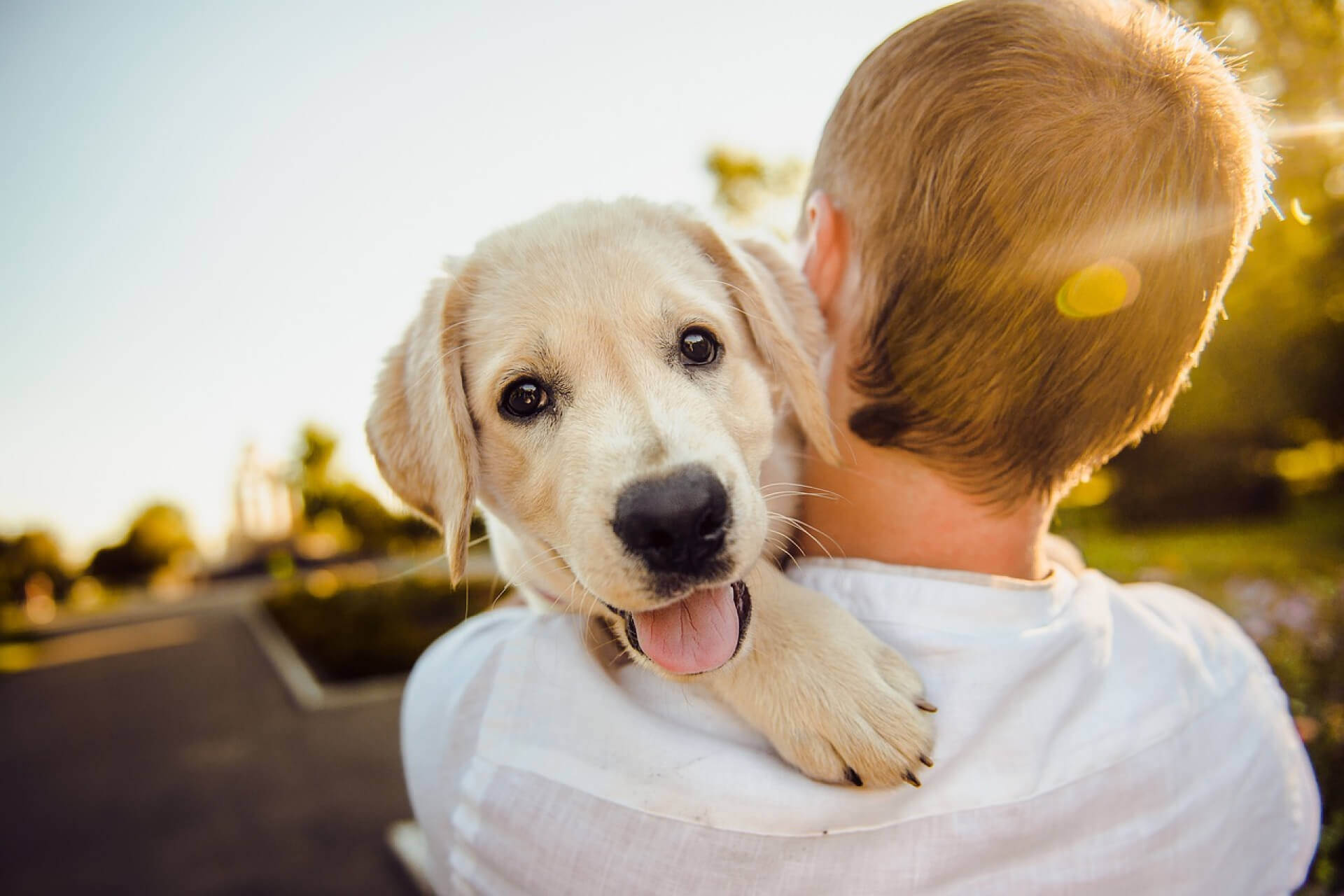Lost pets come home with Peeva.
Your Pup Needs to Stay Fit, Too

Dogs can get fat — really fat.
This should come as no surprise, as more American adults and children suffer from obesity today than ever before, and that’s rubbing off on the pets as their two-legged companions dole out one too many treats. Though often hilarious, the consequences are dire. Overweight canines are at greater risk of health conditions, from osteoarthritis to diabetes to cardiovascular disease, just like people.
If your four-legged friend is looking a bit thick around the edges, you need to get them back in shape. That means a nutritious diet and plenty of exercise. Here are some suggestions to get started in the right direction.
Fix Their Diet
The first step is reading the labels of whatever chow you buy, and looking up the first fiveingredients online to see if they’re healthy or not. However, don’t rely too much on shelf-stable products, as they contain a lot of preservatives. Instead, switch to organic options that boost energy and give your dog a shiny coat. Taste of the Wild Grain-Free Natural Dog Food and Natural Ultramix Grain-Free Dog Food have won over many pups, along with their owners.
After learning about keeping your pup fit, discover the benefits of daily walks for both you and your dog.
Deal Out Low-Cal Treats

You can still show your pup some love and reward good behavior; just keep the calorie count and fat content at a minimum. It’s relatively cheap if you’re willing to spend a little time in the kitchen. An expert at the Nest recommends whipping up some trail mix or dog biscuitswith organic flour and just a few bacon bits for flavor.
Make a Workout Plan
This may be a long-term effort, so it’s best to build time into your schedule to stay consistent, no matter how busy you are. After your pup gets used to their daily exercise, they’ll be sure to remind you when it’s time to head outside for some fun in the sun. In fact, it’s likely to strengthen that bond you’re working so hard to cultivate.
Exercise Ball for Dogs
One fantastic tool to keep your canine companion active and engaged is the exercise ball for dogs. Not to be mistaken with regular children’s play balls, these are sturdier, often made with puncture-resistant material suitable for enthusiastic paws and jaws. The concept is similar to exercise balls used in human fitness – it challenges balance, demands focus, and engages multiple muscle groups.
Using the ball can be as simple as encouraging your dog to balance on it or having them push it around with their nose and paws. It’s not only a physical workout but a mental one, too, as they figure out how to maneuver the ball and maintain balance. Plus, it’s a playful break from the routine exercises and can be used both indoors and outdoors. However, always ensure supervision during playtime with the ball to avoid any mishaps and to ensure they’re using it safely.
Exercise Wheels for Dogs
Taking inspiration from the classic hamster wheel, exercise wheels are especially designed for our canine buddies, these wheels provide an endless track for your dog to run on, offering an excellent outlet for their boundless energy.
Perfect for days when the weather isn’t cooperating for an outdoor run or if you’re short on time, the exercise wheel ensures your dog gets the physical activity they need. It’s particularly beneficial for high-energy breeds that require extensive daily exercise to remain content. As they familiarize themselves with the wheel, it becomes a fun challenge for them, mentally stimulating as they pace themselves on the moving track.
Before introducing your dog to the exercise wheel, it’s vital to ensure the size and sturdiness are appropriate for their breed and weight. Supervised initial sessions can help your pet get accustomed to this new workout equipment, ensuring they enjoy it safely.
Play Fetch
As for what to do during your daily doggy exercise routine, there’s no real reason not to stick with the classics, and this is one of them. Not all pups are naturals at chasing down a stick and bringing it back to you, but there are ways to teach them. The key is motivation, according to Cesar’s Way, and you’ll get that from those healthy treats or a bit of extra affection.
Run Together
Just bring them along with you on your morning or evening trot, though you may have to slow down the pace a little if they’re out of shape. The whole experience will be more rewarding with the right leash, which should be comfortable for the pup and easy to handle for you.
Go Swimming
If you live near the sea, a lake or a river, then you’re in luck, especially if your pup is a water-loving variety, like a labrador retriever or a poodle. You won’t even have to tell them to dive in, as they’ll be way ahead of you, burning off that extra layer of fat as they paddle around to their heart’s content.
Hit the Dog Park

They’ll get the exercise they need on their own if it’s an off-leash facility; just make sure they’re ready, as there may be a lot of social pressure from other dogs. See how they behave while still leashed, and whether or not they bark or lunge at other woofers when they approach. That’s one sign that they need to get used to the local terrain before being let loose.
Walk It Off
Yes, this counts as exercise, even if it’s just a leisurely stroll down the block so your pup can take an evening potty break. However, your efforts will be much more effective by setting a brisk pace that elevates their heart rate and burns some calories; a 30-minute session should be just about right for dogs on the chunky side. You’ll be able to walk longer as they get thinner.
Don’t forget that these activities will keep you in shape, too. You’re killing two birds with one stone, and whole lot of calories as well.
FAQs: Keeping Your Dog Fit and Healthy
1. Should dogs drink water after exercise?
Yes, it’s essential for dogs to rehydrate after exercising. However, it’s advisable to let your dog cool down for a few minutes before offering water, especially after intense activity. Offering water immediately might cause them to drink too rapidly, which can lead to vomiting. Always ensure that the water is fresh and served in a clean bowl. Encourage them to drink in moderation and avoid gulping down large quantities at once.
2. Are stairs good exercise for dogs?
Stairs can be an excellent exercise for dogs, offering both cardio benefits and muscle toning, especially for the hind legs. It’s similar to humans climbing stairs, which provides a workout for various muscle groups. However, it’s essential to ensure that your dog is fit for such an activity. Older dogs or those with joint issues should be monitored closely, as repetitive stair climbing might exacerbate their condition. Always start with a few rounds and gradually increase as your dog gets accustomed to the activity.
3. How much exercise does my dog need? Is there a calculator?
The amount of exercise a dog needs depends on its age, breed, size, and overall health. As a general guideline, dogs need anywhere between 30 minutes to 2 hours of activity each day. Active breeds like Border Collies or Labradors may require more intense exercise, while smaller or older dogs might do well with a moderate walk. While there’s no one-size-fits-all calculator, several online platforms offer exercise estimations based on breed and age. Always consult with your veterinarian to determine the optimal amount and type of exercise for your specific dog.
Peeva: Where Lost Pets Find Their Way Home
Transform your pet’s microchip into a lifeline. 24/7 phone support and lost pet alerts ensure your pet gets the help they need, when they need it.
You Might Be Interested In
- Health, Wellness, Nutrition, Microchipping




